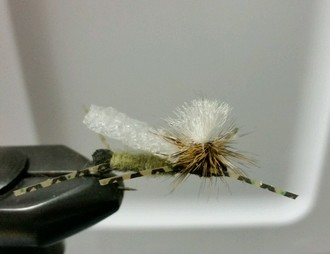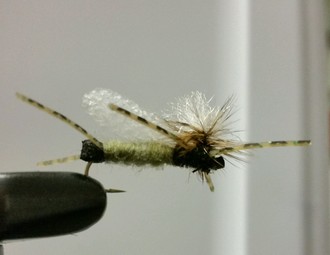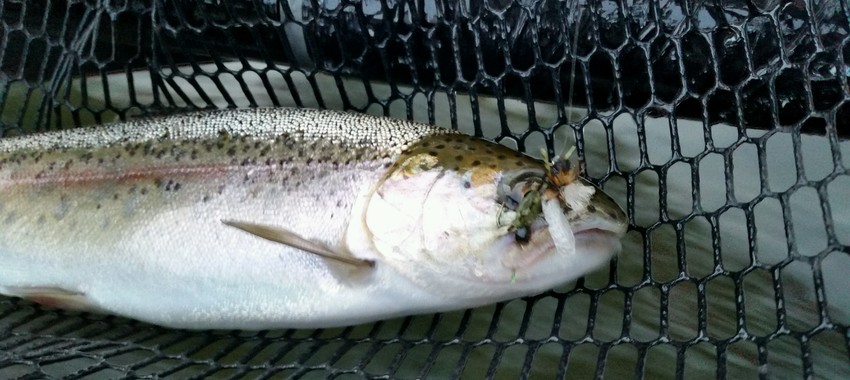Fishing Report, Drought Info, and a Fly
March 24, 2015
Well we sure have had some nice weather over the past couple of weeks. Daytime temps in the mid-60's, even up to 70 a couple days, and mild nighttime temps in the mid to upper 30's and sometimes not dipping below the 40's.Usually this time of year those temperature combinations = blown river. However, with our low snowpack this year, especially in the lower elevations, the river has been in remarkable shape. Yes, we have had some slight ups and downs in river flow, but overall the flows have stayed fairly consistent. In fact, it was so low their a couple weeks ago we welcomed the slight bump in river flows. The extra water creates more available habitat for the fish, and a little color in the water makes them more willing to rise to our dry flies.
Fish Handling & Drought:
Before I get to the fishing report, I wanted to reiterate Joe's fish handling post from a few weeks ago, which you can read here. Working in agriculture in the Yakima Valley, and as a Fly Fishing Guide on the Yakima River, I am constantly looking at Snowpack levels this time of year, and right now we are well below our normal snowpack for the areas that feed the Yakima River. Yes, the Reservoirs up on Snoqualmie Pass are near 100% full, but as soon as those lakes start to feed the Yakima River in the irrigation season they will empty quickly, and there is not much snow to replace what we use. A drought has been issued by the Dept. of Ecology for the entire Yakima Basin, which you can read some FAQ's about here if you are interested. What this means for fisherman is that we can expect lower than normal flows during the summer months. A warm and dry summer is forecast for Washington, so with lower summer flows we will most likely see some pretty warm water temps on the Yakima River this summer. It is imperative that we all take as much care in handling our fish as possible. Yes, the water temps are nice and cool right now, but if we do not handle our fish with care now, they may be at a disadvantage going into the warmer months. We want to keep the fish as healthy as possible now so they are in excellent shape and in peak health when they head into the coming summer. Make sure to pinch those barbs and double check that you have pinched them completely. Try rolling the hook a little in your hemostats/pliers to really get that barb all the way mashed or completely broken off. Some of the larger dry flies we fish right now are hard to get the barb completely mashed down. Keep the fish in the (rubber) net, pop the fly out as quickly as possible, and get 'em back in the water. Try not to handle the fish at all if possible. Let's all hope for some spring snow over the next few weeks. Rant over.
Fishing Report:
The fishing has been good recently, with some days better than others. Not only are the fish still up on Skwala's, but on cloudy days we are seeing a fairly decent Baetis hatch. This past Saturday I also saw a few March Browns flying around in the lower canyon, so be ready for that hatch coming up in the within next couple weeks (especially up in the Farmlands). I found a bunch of Skwala Nymphs under rocks just at the rivers edge this past Saturday as well, along with quite a few adults floating on the water, so the Skwala fishing should remain strong for at least another week or two. If you are fishing on a bright, sunny day, focus your efforts on nymphs and streamers in the morning, and then switch over to dries as the sun dips behind the canyon walls revealing the shady banks. Stonefly nymph's (Pat's, 20-inchers, etc.) with a small nymph (Jig-head Pheasant Tail, Tungsten Ready Baetis, etc.) has been a good set up. On a cloudy day you can start with a dry-dropper set up and fish it all the way until dark. You might even try a double dry set up, with a Skwala dry as your lead fly, and a #16 or #18 Baetis dry as a trailing fly. In the right sections there have been fish up consistently feeding on Baetis, and more often than not they will eat a Skwala, but there are some picky guys as well that will only eat the Baetis. If the river does come up a bit on the day you are fishing, don't forget about San Juan Worms, and Streamers tend to work well in that situation also.
A Fly for the Tying Kind:
One of my good fishing buddies, Cody, showed me this fly a few years back. I don't know what the name of it is, but I do know it is a commercial pattern (not trying to take credit for this one). I haven't been able to find it anywhere for sale though, and after a banner day a few springs ago using this pattern, I tied up a few dozen. Over the past few years I have made a couple minor adjustments to it, and the recipe below is now one that I tie in preparation for the Skwala hatch every winter. It has been a very consistent producer for me, and become one of my favorite, and most used, Skwala patterns. It has some great fishing qualities: the body sits low in the water just like the natural, the wing helps it to stay floating and allows it to hold up a smaller dropper, and the rubber legs give it some great "natural" movement in the water. This fly is also pictured in the mouth of the fish above. Here is the recipe:


Hook: TMC 5212 (or equivalent) #8 - #10
Thread: UTC 70 Brown Olive
Egg Sac: 3mm Black foam, cut to shape
Tail: Olive/Speckled Black Sili-Legs
Ribbing (Optional): UTC 140 Brown
Body: Olive Dry Fly Dubbing (I like to use one with a little sparkle in it)
Wing: 3mm open celled packing foam (you can find this stuff in a lot of electronics packaging boxes, laptops, etc.). You can also mark the wing up a little bit with a black or brown Sharpie
Parachute Post: White Z-Lon (or Poly Yarn)
Hackle: Tan Dyed Grizzly (if you don't have that, straight Grizzly or Olive Dyed Grizzly works fine as well)
Thorax: 4 strands Peacock Herl & 1 strand fine or small gold wire twisted into a rope
Legs: Same Sili-Legs as the tail
Head: 3mm Black Foam (tie the egg Sac in, but leave the strip long enough to tie over the entire hook shank and then leave some out over the eye of the hook for the head)
Fish Handling & Drought:
Before I get to the fishing report, I wanted to reiterate Joe's fish handling post from a few weeks ago, which you can read here. Working in agriculture in the Yakima Valley, and as a Fly Fishing Guide on the Yakima River, I am constantly looking at Snowpack levels this time of year, and right now we are well below our normal snowpack for the areas that feed the Yakima River. Yes, the Reservoirs up on Snoqualmie Pass are near 100% full, but as soon as those lakes start to feed the Yakima River in the irrigation season they will empty quickly, and there is not much snow to replace what we use. A drought has been issued by the Dept. of Ecology for the entire Yakima Basin, which you can read some FAQ's about here if you are interested. What this means for fisherman is that we can expect lower than normal flows during the summer months. A warm and dry summer is forecast for Washington, so with lower summer flows we will most likely see some pretty warm water temps on the Yakima River this summer. It is imperative that we all take as much care in handling our fish as possible. Yes, the water temps are nice and cool right now, but if we do not handle our fish with care now, they may be at a disadvantage going into the warmer months. We want to keep the fish as healthy as possible now so they are in excellent shape and in peak health when they head into the coming summer. Make sure to pinch those barbs and double check that you have pinched them completely. Try rolling the hook a little in your hemostats/pliers to really get that barb all the way mashed or completely broken off. Some of the larger dry flies we fish right now are hard to get the barb completely mashed down. Keep the fish in the (rubber) net, pop the fly out as quickly as possible, and get 'em back in the water. Try not to handle the fish at all if possible. Let's all hope for some spring snow over the next few weeks. Rant over.
Fishing Report:
The fishing has been good recently, with some days better than others. Not only are the fish still up on Skwala's, but on cloudy days we are seeing a fairly decent Baetis hatch. This past Saturday I also saw a few March Browns flying around in the lower canyon, so be ready for that hatch coming up in the within next couple weeks (especially up in the Farmlands). I found a bunch of Skwala Nymphs under rocks just at the rivers edge this past Saturday as well, along with quite a few adults floating on the water, so the Skwala fishing should remain strong for at least another week or two. If you are fishing on a bright, sunny day, focus your efforts on nymphs and streamers in the morning, and then switch over to dries as the sun dips behind the canyon walls revealing the shady banks. Stonefly nymph's (Pat's, 20-inchers, etc.) with a small nymph (Jig-head Pheasant Tail, Tungsten Ready Baetis, etc.) has been a good set up. On a cloudy day you can start with a dry-dropper set up and fish it all the way until dark. You might even try a double dry set up, with a Skwala dry as your lead fly, and a #16 or #18 Baetis dry as a trailing fly. In the right sections there have been fish up consistently feeding on Baetis, and more often than not they will eat a Skwala, but there are some picky guys as well that will only eat the Baetis. If the river does come up a bit on the day you are fishing, don't forget about San Juan Worms, and Streamers tend to work well in that situation also.
A Fly for the Tying Kind:
One of my good fishing buddies, Cody, showed me this fly a few years back. I don't know what the name of it is, but I do know it is a commercial pattern (not trying to take credit for this one). I haven't been able to find it anywhere for sale though, and after a banner day a few springs ago using this pattern, I tied up a few dozen. Over the past few years I have made a couple minor adjustments to it, and the recipe below is now one that I tie in preparation for the Skwala hatch every winter. It has been a very consistent producer for me, and become one of my favorite, and most used, Skwala patterns. It has some great fishing qualities: the body sits low in the water just like the natural, the wing helps it to stay floating and allows it to hold up a smaller dropper, and the rubber legs give it some great "natural" movement in the water. This fly is also pictured in the mouth of the fish above. Here is the recipe:


Hook: TMC 5212 (or equivalent) #8 - #10
Thread: UTC 70 Brown Olive
Egg Sac: 3mm Black foam, cut to shape
Tail: Olive/Speckled Black Sili-Legs
Ribbing (Optional): UTC 140 Brown
Body: Olive Dry Fly Dubbing (I like to use one with a little sparkle in it)
Wing: 3mm open celled packing foam (you can find this stuff in a lot of electronics packaging boxes, laptops, etc.). You can also mark the wing up a little bit with a black or brown Sharpie
Parachute Post: White Z-Lon (or Poly Yarn)
Hackle: Tan Dyed Grizzly (if you don't have that, straight Grizzly or Olive Dyed Grizzly works fine as well)
Thorax: 4 strands Peacock Herl & 1 strand fine or small gold wire twisted into a rope
Legs: Same Sili-Legs as the tail
Head: 3mm Black Foam (tie the egg Sac in, but leave the strip long enough to tie over the entire hook shank and then leave some out over the eye of the hook for the head)
-
We can never say enough on the the catching and handling of all WILD TROUT, Whitefish, on all Catch and Release waters. We should also consider the right weight rod, leader and tippet, to be able to land a fish in a timely manor.. Let's CATCH and RELEASE each WILD TROUT as if it's the TROUT on earth.
-
You have a gem of a river and my first visit a few weeks ago left me wanting more. It was a nice weekend away from Vancouver Canada. Your trout are in great shape so I think it's safe to say that many people are looking after and handling the trout well. GREAT JOB!!!
-
I was hoping to come out there and fish in the middle to late part a September. Sounds like I should rethink this due to low water and warmer water temperatures? I'm sure drifting will be out a the question what about wading?
![Reds Fly Shop [logo]](/img/reds-fly-shop/logo.png)
